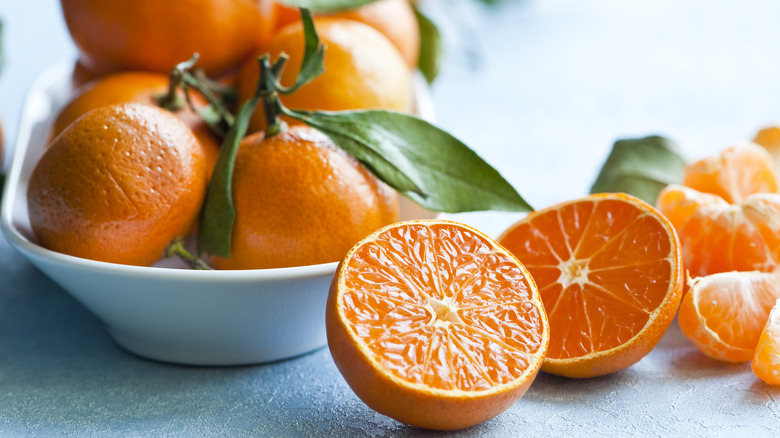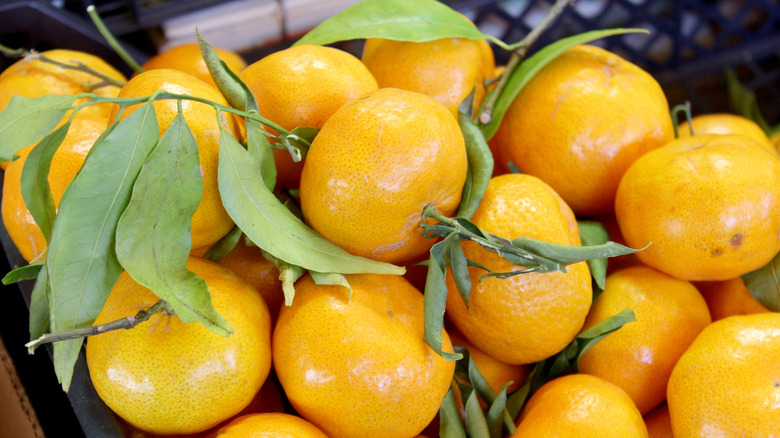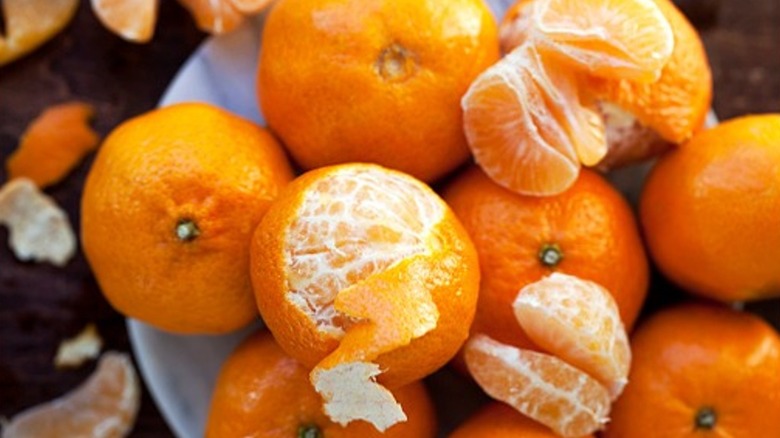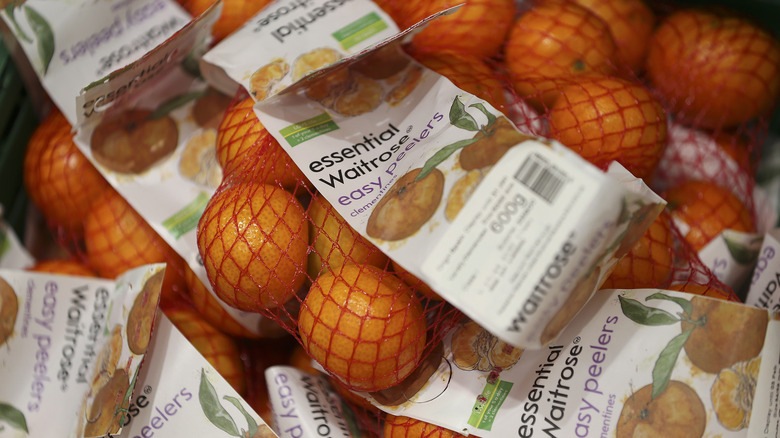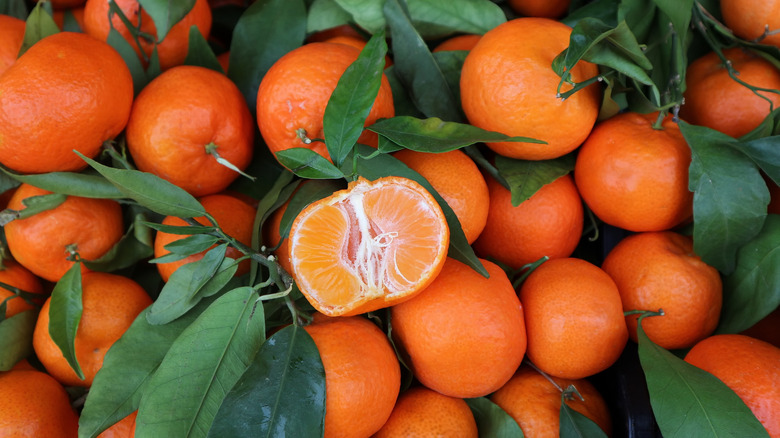The Difference Between Tangerines And Clementines
One of them has an old-fashioned given name and the other is the title of a Led Zeppelin song, and the differences end there, right? Of course not. These two orange citrus fruits frequently get confused with each other and check many of the same culinary boxes, but tangerines and clementines are distinct and delicious in their own rights with properties that are important to consider when choosing which to go with.
First, let's cover the similarities. As stated, both tangerines and clementines are citrus fruits, specifically oranges. Even more specifically, both are types of mandarin oranges. This umbrella category covers oranges bred to be smaller and flatter than other oranges with a sweeter flavor and a rind that is easier to separate from the fruit inside. As members of the citrus genus, tangerines and clementines are rich in vitamin C and micronutrients. Potassium, calcium, magnesium, and pantothenic acid are all abundant in the juicy, pulpy flesh of citrus fruits.
Tangerines and clementines are both great for snacking. That rind that peels right off and their flavor erring more on the sweeter side than the acidic makes them favorites for hungry kids and parents in search of nutritious, appealing foods. But we're diving a bit deeper into what separates the two.
What is a tangerine?
If you've ever tangled with a tangerine (Citrus tangerina) versus a standard navel orange, the difference is clear. They are typically bright orange and considerably more squat and you probably had a much easier time peeling the tangerine. The flavor is sweet without being overpowering with a distinctly tart element that provides balance. The peel of a tangerine is easy to work with, but certainly not the most yielding of the mandarin fruits. It also contains essential oils that contribute to a tangerine's distinct aroma and flavor, making it a popular addition to various culinary creations. Tangerines are not only enjoyed fresh but are also used in salads, desserts, and beverages.
Tangerines have been cultivated in Eastern Asia for over 3,000 years and made their way to Europe and the Western world via traders on the Silk Routes. Many filtered through the Moroccan port of Tangiers, where the fruit picked up its name. Favoring warm climates, tangerines are now cultivated in the U.S. Sun Belt states, like California, Florida, and Texas.
What is a clementine?
Clementines (Citrus clementina) are small, seedless wonders that are remarkably easy to peel. The skin can be slightly redder than that of a tangerine. The flesh is abundantly sweet and practically bursting with juice, while the thin, loose skin effortlessly separates from the juicy segments, making them an ideal snack for those who appreciate convenience. The absence of seeds only enhances their appeal, offering a hassle-free and delicious fruit. Owing to this ease of eating and popularity with kids, clementines are often marketed in the U.S. under the names Cuties, Sweeties, and Halos.
The origin of this particular citrus varietal is a bit shrouded in mystery. They appear to have emerged in Algeria in the early 20th century as a spontaneous hybrid from the interbreeding of two different fruits. The story goes that the name is an homage to Clément Rodier, a French monk, within whose Algerian garden the fruit was discovered. However, other researchers say the fruit came from China thousands of years earlier. Clementines were brought to the U.S. in 1909, where they were first cultivated in Florida and are now grown in commercial and home citrus groves alike.
Clementines have sensitive skin
Clementines, renowned for their exquisite flavor and ease of peeling, present a logistical challenge due to their thinner skin when compared to tangerines. While the thin skin contributes to the delightful eating experience, it also renders clementines more fragile and susceptible to damage during shipping. The delicate nature of their peel makes them prone to bruising and dehydration, impacting both the appearance and quality of the fruit upon arrival.
In contrast, tangerines generally have thicker skins, providing a protective layer that helps withstand the rigors of transportation. The sturdier peel of tangerines reduces the risk of damage, ensuring that the fruit arrives at its destination in better condition. This difference in skin thickness affects the logistics of the citrus industry, influencing packaging, handling, and transportation practices to maintain the quality of clementines during their journey from orchard to consumer. Despite this challenge, the unique appeal of clementines continues to make them a sought-after delicacy.
A tangerine's tarter taste
Tangerines, distinguished by their slightly more tart flavor and robust skin filled with citrus oils, are a great citrus fruit to use for various culinary applications. The heightened tartness of tangerines adds a dynamic element to dishes, balancing sweetness and acidity. Their robust skin, laden with essential oils, introduces a fragrant citrusy aroma to dishes that enhances the overall sensory experience.
In savory dishes, tangerines can be used to create zesty marinades for meats or seafood, infusing a burst of citrusy brightness. The oils in the peel contribute depth and complexity to sauces and dressings. In desserts, the tartness of tangerines complements the lovely orangey sweetness, making them an excellent addition to pies, cakes, and sorbets.
Moreover, the oils in tangerine peels can infuse flavor into beverages such as cocktails or herbal teas, elevating the drink with a citrusy essence, which is why you so often see a twist of peel in them. The robust nature of tangerine skin also makes it suitable for creating candied peels, a delightful garnish or snack.
Clementine's seed-free style
Clementines, celebrated for their seedless nature, are a triumph of cultivation. The seedlessness of clementines is a result of careful selective breeding over the years by citrus growers and horticulturists. Their techniques have resulted in varieties that exhibit a reduced number or complete absence of seeds.
Typically, farmers will plant groves of identical clementine tree clones that have high rates of parthenocarpy, whereby fruits develop on the trees without fertilization. Self-incompatibility means that these trees cannot fertilize each other and so produce sterile — seedless — fruit. This is great for the consumer. Additionally, nets are often deployed to keep bees from pollinating while the trees are in bloom as any fruit that grows from cross-pollination would bear seeds. As such, no seeds can be harvested and grafting is generally the method used to keep the clementine trees producing fruit year after year in place of traditional pollination.
